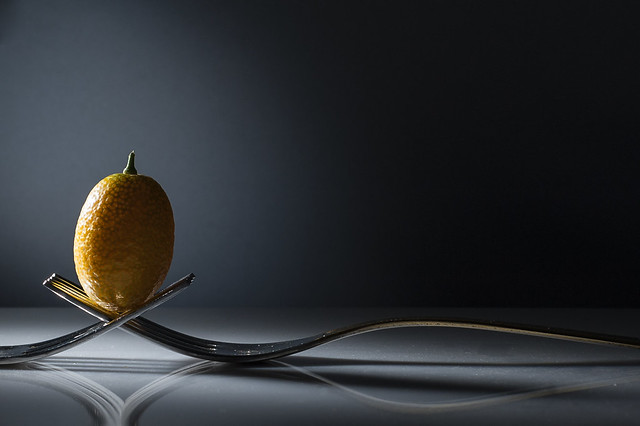I am accustomed to a certain amount of grotesquerie by Emma Sovich

Editorial intern Brandon Hansen on today's bonus story: Emma Sovich's flash will shift your insides, and isn't sorry about it. This nasty-beautiful thing refuses to take its foot off the gas pedal; it will forever change the way you think about uteruses.
I am accustomed to a certain amount of grotesquerie
Visualized: a kumquat. Not a kumquat. A knot of muscle and tissue, benign. Visualized: a grainy protrusion the size of a ten-week embryo. No fingers or toes. Submucosal, embedded in myometrium. I have bled for four months.
I am 28 and childless, one year older than my mother when she bore me. When first she saw me I was a twist of pixels on a small screen. My fibroid now a twist of pixels. The technician prints a strip; my uterus in five slices, ovaries and all.
Blood squeaks deep in my ears when I stand, sit, recline. Weekly I expend 40 super tampons, 32 overnight pads. A chair lives in the kitchen so I can sit to cook. I sleep in my my bloodstained sheets. I order delivery. Blood clots and tissue wrack my abdomen.
My mother, my friends, my boyfriend’s mother bully me to the ER for three pints of blood. I post a photograph of a pint to Facebook, forcing myself to explain, reassure, elaborate. I take 10 mg of norethindrone a day for months, waiting for surgery. I am crazy with hormones.
I am a 28-year-old woman with a recent history of heavy bleeding and anemia. My doctor dictates into the record. To visualize the fibroid, she inserts an hysteroscope into my vulva and then my cervix, which is gently dilated up to size 31.
My cervix is dilated only after I am placed in a dorsal lithotomy position with my feet in Yellofin stirrups, after I am prepped and draped in the usual sterile fashion. I have never been so fashionable. A speculum is inserted, a tenaculum applied to the anterior lip of my cervix to commence dilation.
Morcellate. Mince. My doctor has approximately thirty minutes. Visualize: she shaves more cautiously than I shave my legs, which I often do not shave at all. She shaves the fibroid with a Smith and Nephew’s TRUCLEAR morcellator.
The specimens my doctor remove consist of multiple tan, soft, irregular fragments of tissue with a small amount of associated blood clot. Pathology examines them, but fibroids are not cancerous. My boyfriend’s mother has carried a grapefruit and an orange through two pregnancies and menopause.
My entire specimen dimensions are 2.5 x 2.0 x 0.5 cm. Half the kumquat.
I tolerate the procedure well. Eight months later I bleed through a super tampon, an overnight pad, a sweatshirt, and into the driver’s seat of my car--in ten minutes. Everything in my body is leaving from this hole. Blood squeaks in my ears.
In the ER, I am transferred from radiology to a bed without underwear. I can barely stand. I free bleed onto the floor and the nurses and I admire the steady flow of crimson, the patterns it creates as it splashes on my legs, the radiator, the side of the bed. The nurses laugh when I ask for adult diapers but I am glad for them. Diapers, nurses. Five units of B positive. A shot of estrogen enough to seize my leg. Progesterone enough to make me weep openly. 40 mg four times a day. I do not want children. I am positive.
My mother offers my sister’s uterus for my future children. My doctor rewinds. I am a 29-year-old woman with a history of heavy bleeding and anemia. The half kumquat further minced. I am morcellated. My pelvis tender for weeks. But the fibroid: gone.
My blood now entirely borrowed.
I am not alone. The NIH states that 70-80 percent of women develop fibroids. Most fibroids are benign. Acquaintances on Facebook tell me about polyps, about endometriosis, about polycystic ovarian syndrome. No one understands our bodies. When I tell women about my horrific body they have also been horrified by their bodies. By horrified I mean resigned. We can’t go anywhere without bleeding.
Emma Sovich is a poet and book artist from Maryland. Her first book of poetry, Wendy Wendy Wendy, is forthcoming from Red Paint Hill Press. Her chapbook, None of Us Know Any Stories, is available through dancing girl press. She has writing forthcoming in Denver Quarterly and Crab Orchard Review, and previously in Salt Hill, Sixth Finch, Hayden's Ferry Review, and others. Her book arts works have been shown in nine states, and have homes in the libraries of Indiana University, University of Florida, the Newberry Library, and elsewhere. See them at emmasovich.com.




